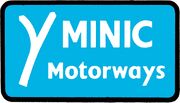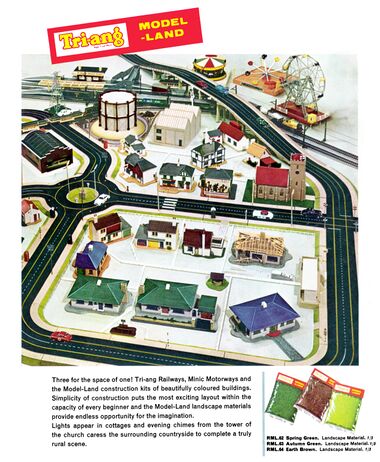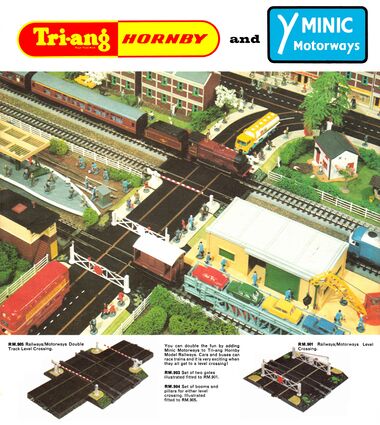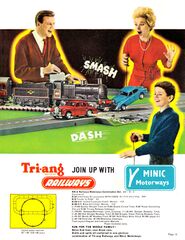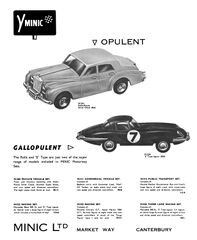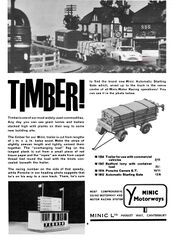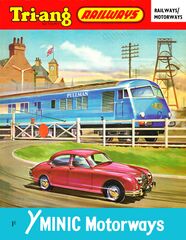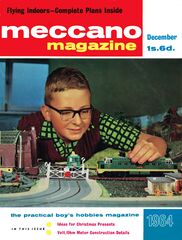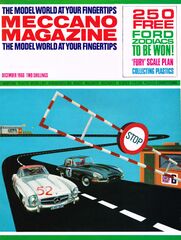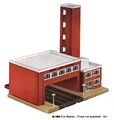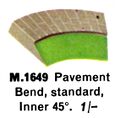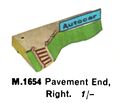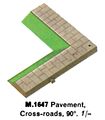Category:Minic Motorways
| Slotcar systems |
|---|
Minic Motorways |
| 1960s - |
| Airfix/MRRC | Champion | Circuit 24 | Cox Slot Racers | Formula 152 | Highways | Matchbox Motorway | Minic Motorways | Monogram | Revell Model Racer | Scale Raceway Models (SRM) | Scalextric | VIP Raceways |
1964: Model-Land and Minic Motorways [image info]
1965: Arkitex, Model-Land and Minic Motorways [image info]
1966: Urban scene, Minic Motorways [image info]
1966: Tri-ang Hornby and Minic Motorways [image info]
Tri-ang's Minic Motorways slotcar system appeared in the early 1960s. A critical distinguishing feature of the system to most alternatives was that it was designed to 1:76 scale, for interoperability with the company's successful Tri-ang Railways range. While most slotcar systems were designed and marketed as toy racetracks, the Minic Motorways system was designed to allow model railway layouts to incorporate moving road traffic, and around more model-railway-like design sensibilities.
Early advertising was admittedly crude, and seemed to market the system as an exciting way of having a barebones model railway loop and grey slotcar road loop intersecting, with the constant danger of having your car hit by a freight train (unless you were careful). However, the system rapidly expanded, with clip-on pavements and grass verges allowing it to coexist more politely with "proper" model railway layouts, and with level crossings and "intersection logic" to prevent cars and trains hitting each other. One could watch the surreal sight of cars approaching a level crossing, and apparently seeing the approaching train and pausing until it was safe to cross, then continuing. This gave a layout's behaviour a far greater sense of sophistication – one could almost imagine the little drivers inside the cars tut-tutting as they waited for the train to pass before impatiently scooting off again.
Promotional text
Off to a Racing Start ... and Ahead in Every Direction, with Tri-ang MINIC Motorways
Every Minic Motorways Set holds the promise of a young lifetime of pride and pleasure in building the world's finest 00 scale motorway system. As you will see in the ensuing pages a wide variety of tough track sections clip quickly and firmly together without the aid of tools or locking devices.
Racing circuits of any size and contour can easily be assembled ready for dashing sports cars to fight their exciting way to the chequered flag.
Beautifully detailed cars and commercial vehicles can be driven at varying speeds forward and in reverse – just like the real thing!
Build in your Tri-ang Railways, too! Level crossings, road/rail junctions, the incredible car transporter and loading ramp set a new high standard in fun and authenticity.
In addition, the models of modern buildings, which can be seen on pages 18 and 19, will complete the realism of any chosen layout.
All models are designed to operate from 12/15 colts D.C. (Direct Current). For operating from A.C. mains electricity supply a suitable power controller having an output of 12/15 volts D.C. is required. For battery operation a battery container and three 4½ V. dry batteries are required.
For simplicity, versatility and durability Minic Motorways have no equal.
Range
The Minic Motorways range expanded again with a range of roadside buildings with "added value" features such as smoking chimneys and automatically opening garage doors, and were supplemented by the Tri-Ang Model-Land range of pre-coloured (but paintable) plastic kits of buildings and sets of paintable people. Level crossings had flashing beacons, crossroad intersections had mutual cutouts to auto-pause traffic, some road sections had railway tracks as well, and you could even drive your car right onto a road or railway car transporter, or straight onto a car ferry. More complicated road junctions (including a four-way roundabout) allowed you to switch the default behaviour of a car approaching a "fork", to roadway systems with really quite complex paths.
The system was then promoted as also compatible with the 00-scale sub-range of the Tri-ang Spot-On Arkitex building kits which allowed faithful recreations of 1960s office buildings, and of course, one also had the range of railway station and trackside buildings in the Tri-ang Railways range to play with (it would be natural for a large station or a goodsyard to have a road alongside).
With the takeover by Tri-ang of Meccano Ltd, and the incorporation of some parts of the Dublo range into the new merged Tri-ang Hornby system, advertising showed layouts built of a mixture of Minic Motorways and Tri-ang Hornby buildings.
In addition to the racing and "rallying" sets, there was also a Holiday Highway set (M.1518), a Crime Patrol set (M.1519), and a Heliport International set (M.1527)
Vehicles
The idea of a realistic combined road and railway layout was reflected in the wide range of vehicles available: While Minic Motorways did include a few sports cars, some in racing colours (and a Police Car with flashing lights), it also included coaches, double decker buses, lorries, a steam lorry issuing real smoke, and a tank. Given that tank racing wasn't a popular pastime, it was pretty obvious that this wasn't a system designed primarily for racing.
Reinvention
While there were undoubtedly some hobbyists out there who loved the ability to use these complementary ranges of pre-built and kit scenery to construct their own massive animated cityscapes. It must have occurred to Lines Brothers Ltd that they now had an excessively large range, and that actually, what most people bought slotcars for was to make a simple figure-eight track and race cars against their friends and family members – the slotcar race set was a classic family "Christmas tree" toy that allowed the whole family to spend Boxing Day sitting on the lounge floor and playing racecars. This was not the same market as the solitary hobbyist diorama constructor.
Minic Motorways had the wrong name. Although the opening of the UK's first motorway (the M1) in the late 1950s had lent an air of glamour and zeitgeist to the word "motorway", motorways themselves tended to be straight and fairly uninteresting creatures, urban cityscapes weren't technically motorways, and someone wanting to buy a slotcar racing set might not be excited by the rather staid "Minic Motorway" branding. The product line simply had the wrong name for the "racetrack" market, and although Lines Brothers had recently bought the significantly larger 1:32-scale Scalextric system to address that market, Minic Motorways also needed to sell into the racing market to maintain "critical mass".
Triang's new advertising no longer promoted urban realism so much, and concentrated on racing excitement, and with a respectable range of racetrack accessories (including a Dunlop bridge and various racetrack buildings, and a thorough range of layout designs to emulate famous racetracks), the company started using three different branding variations: Minic Motorways, Minic Motor Racing, and Minic Rally Racing. However, this more focused sub-branding perhaps appeared a little later than it should have, by which time the company was bogged down with trying to merge the Tri-ang and Meccano Ltd ranges, and a few short years later the whole Lines Brothers behemoth went bust and were bought by the Airfix group.
Slotcar system extinction
These takeovers would have resulted in a rather absurd range of different incompatible slotcar systems all "under the same roof" – Minic Motorways (Tri-ang, in-house), Scalextric (Tri-ang, bought from Minimodels Ltd), Formula 152 (Wrenn, which Triang had bought a major stake in), Circuit 24 (Meccano Ltd, big in France) and then Airfix's own system Airfix MotorAce / Airfix MRRC (developed by MRRC, which Airfix had taken over).
In the resulting shakedown, Formula 152 disappeared when Triang bought into Wrenn, MRRC were floated off as a separate company, and Minic Motorways became an almost inevitable casualty of the glut of incompatible systems.
The disappearance of so many systems meant that slotcars became again primarily something that you bought at Christmas as a single set, then threw away when something (inevitably) broke. Tragically, the slotcar community had never standardised on interchangeable parts and accessories as the model railway community had, and although cars could often be modified to run on a different system's track, the profusion of incompatible track spacings and connection systems made investing serious money in a roadway system rather risky. If a company decided to "pull the plug" on a system (as happened to Minic Motorways), you couldn't simply buy compatible track (and fencing, etc) from a different manufacturer, and were reliant of the limited number of accessory parts already in existence, and on the second-hand market. The large number of almost compatible proprietary formats "split the market", and made it uneconomical for anyone other then the smallest of niche makers to support other company's current or obsolete ranges.
Advertising
Covers
External links
Subcategories
This category has the following 8 subcategories, out of 8 total.
F
- Minic Motorways Fairground (3 F)
M
- Minic Motorways miscellaneous (12 F)
R
- Minic Motorways raceways (3 F)
V
- Minic Motorways vehicles (25 F)
Pages in category ‘Minic Motorways’
The following 2 pages are in this category, out of 2 total.
Media in category ‘Minic Motorways’
The following 136 files are in this category, out of 136 total.
- Aston Martin DB4 GT, Minic Motorways M1573 (TriangRailways 1964).jpg 1,793 × 885; 568 KB
- Austin A40, Minic Motorways M1557 (TriangRailways 1964).jpg 1,390 × 877; 444 KB
- Automatic Cross-Roads Set, Minic Motorways M1623 (TriangRailways 1964).jpg 2,000 × 1,778; 905 KB
- Bedford Lorry with Bale Load, Minic Motorways M1546 (TriangRailways 1964).jpg 1,800 × 1,079; 802 KB
- Bend, Outer, 45deg, Minic Motorways M1616 (TriangRailways 1964).jpg 1,772 × 915; 504 KB
- Bend, Single Track, 45deg, Minic Motorways M1617 (TriangRailways 1964).jpg 1,280 × 677; 278 KB
- Bend, Standard 30deg, Minic Motorways M1615 (TriangRailways 1964).jpg 768 × 688; 195 KB
- Bend, Standard, 45deg, Minic Motorways M1613 (TriangRailways 1964).jpg 1,077 × 706; 275 KB
- Bend, Standard, 90deg, Minic Motorways M1611 (TriangRailways 1964).jpg 1,748 × 789; 470 KB
- Breakdown Lorry, Minic Motorways M1565 (TriangRailways 1964).jpg 1,617 × 1,189; 663 KB
- Bungalow with automatic garage, Minic Motorways M1806 M1807 (TriangRailways 1964).jpg 2,000 × 1,442; 1.03 MB
- Bus Garage, Minic Motorways M1803 (TriangRailways 1964).jpg 2,000 × 1,543; 1.51 MB
- Car Transporter, Minic Motorways M1548 (TriangRailways 1964).jpg 1,946 × 1,425; 1.04 MB
- Car Water Ferry Loading Quay, Minic Motorways M1579 (TriangRailways 1964).jpg 2,000 × 1,118; 791 KB
- Car Water Ferry Set, Minic Motorways M1580 (TriangRailways 1964).jpg 1,982 × 804; 512 KB
- Car Water Ferry, Minic Motorways M1578 (TriangRailways 1964).jpg 1,933 × 1,046; 621 KB
- Caravan, Minic Motorways M1553 (TriangRailways 1964).jpg 1,277 × 953; 482 KB
- Checkpoint Bravo Rally Set, Minic Rally Racing (MM 1966-12).jpg 1,209 × 1,600; 312 KB
- Coach, Minic Motorways M1544 (TriangRailways 1964).jpg 1,869 × 1,016; 796 KB
- Conqueror Tank, Minic Motorways M1569 (TriangRailways 1964).jpg 1,797 × 974; 607 KB
- Cross-Roads, 90deg, Minic Motorways M1623 (TriangRailways 1964).jpg 1,303 × 1,066; 489 KB
- Double Decker Bus, Minic Motorways M1545 (TriangRailways 1964).jpg 1,716 × 1,281; 1,009 KB
- Double Straight, Standard, Minic Motorways M1609 (TriangRailways 1964).jpg 2,261 × 1,165; 711 KB
- E-Type Jaguar, Minic Motorways M1559 (TriangRailways 1964).jpg 1,701 × 952; 514 KB
- Filling Station, Minic Motorways M1801 (TriangRailways 1964).jpg 2,000 × 1,111; 980 KB
- Fire Engine with Flashing Light, Minic Motorways M1550 (TriangRailways 1964).jpg 1,618 × 977; 700 KB
- Fire Station, Minic Motorways M1804 (TriangRailways 1964).jpg 1,899 × 2,000; 1.38 MB
- Go Motor Racing With Minic (MM 1965-10).jpg 1,220 × 1,600; 396 KB
- Gradient Base, Minic Motorways M1628 (TriangRailways 1964).jpg 1,438 × 800; 412 KB
- Gradient Base, Single Track, Minic Motorways M1635 (TriangRailways 1964).jpg 1,274 × 544; 270 KB
- Gradient Summit, Minic Motorways M1629 (TriangRailways 1964).jpg 1,428 × 724; 412 KB
- Gradient Summit, Single Track, Minic Motorways M1636 (TriangRailways 1964).jpg 1,364 × 541; 298 KB
- Grass Strip, Centre, Straight, Minic Motorways M1690 (TriangRailways 1964).jpg 1,341 × 652; 338 KB
- Half Straight, Minic Motorways M1602 (TriangRailways 1964).jpg 973 × 747; 241 KB
- Humber Super Snipe, Minic Motorways M1543 (TriangRailways 1964).jpg 1,720 × 972; 525 KB
- Hump Back Bridge Summit, Minic Motorways M1627 (TriangRailways 1964).jpg 1,435 × 737; 441 KB
- Jaguar 3point4, Minic Motorways M1542 (TriangRailways 1964).jpg 1,560 × 868; 479 KB
- Junction Y, 30deg, Minic Motorways M1630 (TriangRailways 1964).jpg 1,486 × 973; 498 KB
- Junction, Left, 90deg, Minic Motorways M1626 (TriangRailways 1964).jpg 1,447 × 1,111; 473 KB
- Junction, Left, Lay-By, Minic Motorways M1633 (TriangRailways 1964).jpg 1,425 × 973; 438 KB
- Junction, Right, 90deg, Minic Motorways M1624 (TriangRailways 1964).jpg 1,718 × 1,005; 524 KB
- Junction, Right, Lay-By, Minic Motorways M1632 (TriangRailways 1964).jpg 1,747 × 852; 507 KB
- Lorry with Container Load, Minic Motorways M1547 (TriangRailways 1964).jpg 1,966 × 1,206; 841 KB
- Meccano Magazine, cover (MM 1964-12).jpg 1,365 × 1,800; 370 KB
- Mercedes 300 SL, Minic Motor Racing (TriangMag 1965-04).jpg 3,000 × 2,354; 3.6 MB
- Mercedes Benz 220S, Minic Motorways M1556 (TriangRailways 1964).jpg 1,474 × 897; 462 KB
- Mercedes Benz 300 SL, Minic Motorways M1558 (TriangRailways 1964).jpg 1,546 × 911; 493 KB
- Minic Motor Racing, logo (TriangMag 1965-04).jpg 681 × 456; 111 KB
- Minic Motorway, King Charles Sports Centre, Leeds, advert (MM 1966-10).jpg 1,271 × 1,600; 443 KB
- Minic Motorways raceway, minimal five-track racing layout (MMR ~1962).jpg 2,998 × 1,844; 1.48 MB
- Minic Motorways raceway, normal five-track racing layout (MMR ~1962).jpg 3,000 × 1,197; 1.32 MB
- Minic Motorways raceways leaflet, front (~1962).jpg 854 × 1,200; 399 KB
- Minic Motorways, logo (1966).jpg 1,336 × 762; 219 KB
- Minic slotcar systems, 1966 catalogue, advert (MM 1966-10).jpg 2,243 × 3,000; 4.97 MB
- Model Land, Minic Motorways, Triang Railways (TriangRailways 1964).jpg 2,470 × 3,000; 4.4 MB
- Motel Chalet and Garage, Minic Motorways M1814 (TriangRailways 1964).jpg 2,000 × 1,231; 966 KB
- Motel Restaurant, Minic Motorways M1813 (TriangRailways 1964).jpg 1,612 × 1,139; 896 KB
- New Mini-Contact Motor, Minic Motorways (TriangMag 1965-05).jpg 2,209 × 3,000; 2.46 MB
- New Minic Mini-Contact Motor, Minic Motorways (TriangMag 1965-03).jpg 2,412 × 3,000; 610 KB
- Operating Big Wheel, Minic Motorways M2001 (TriangRailways 1964).jpg 1,560 × 2,000; 1.25 MB
- Operating Octopus, Minic Motorways M2003 (TriangRailways 1964).jpg 2,000 × 1,379; 969 KB
- Operating Roundabout, Minic Motorways M2002 (TriangRailways 1964).jpg 2,000 × 1,332; 1.02 MB
- Pavement Bend, Inner, 45deg, Minic Motorways M1662 (TriangRailways 1964).jpg 1,416 × 809; 307 KB
- Pavement Bend, Outer, 45deg, Minic Motorways M1661 (TriangRailways 1964).jpg 1,155 × 717; 184 KB
- Pavement End, Left, Minic Motorways M1653 (TriangRailways 1964).jpg 796 × 557; 141 KB
- Pavement End, Right, Minic Motorways M1654 (TriangRailways 1964).jpg 730 × 629; 130 KB
- Pavement Gradient Base, Left, Minic Motorways M1655 (TriangRailways 1964).jpg 1,172 × 527; 226 KB
- Pavement Gradient Base, Right, Minic Motorways M1656 (TriangRailways 1964).jpg 1,117 × 492; 204 KB
- Pavement, Roundabout, Minic Motorways M1648 (TriangRailways 1964).jpg 742 × 681; 153 KB
- Police Car with Flashing Light, Minic Motorways M1552 (TriangRailways 1964).jpg 1,564 × 1,134; 532 KB
- Porsche Carrera GT, Minic Motorways M1574 (TriangRailways 1964).jpg 1,512 × 910; 474 KB
- Railway Goods Shed, Minic Motorways M1808 (TriangRailways 1964).jpg 1,600 × 781; 566 KB
- Railway-Motorway Level Crossing, ungated, Minic Motorways M901 (TriangRailways 1964).jpg 1,600 × 1,196; 627 KB
- Relay with Leads, Minic Motorways M1620 (TriangRailways 1964).jpg 641 × 615; 150 KB
- Renault Floride, Minic Motorways M1560 (TriangRailways 1964).jpg 1,425 × 819; 385 KB
- Road-Rail Buffer Stop, Minic Motorways RM913 (TriangRailways 1964).jpg 1,188 × 585; 208 KB
- Road-Rail Buffer Stop, Minic Motorways RM914 (TriangRailways 1964).jpg 1,218 × 583; 210 KB
- Road-Rail Junction, Type A, Minic Motorways RM911 (TriangRailways 1964).jpg 1,118 × 764; 343 KB
- Road-Rail Junction, Type B, Minic Motorways RM912 (TriangRailways 1964).jpg 1,152 × 764; 299 KB
- Road-Rail Track, Straight 6in, Minic Motorways RM910 (TriangRailways 1964).jpg 1,227 × 764; 331 KB
- Rolls and E-Type Jaguar, Minic Motorways (TriangMag 1965-01).jpg 2,458 × 3,000; 1.38 MB
- Rolls Royce Silver Cloud, Minic Motorways M1541 (TriangRailways 1964).jpg 1,518 × 834; 428 KB
- Roundabout, Minic Motorways M1621 (TriangRailways 1964).jpg 1,978 × 1,257; 838 KB
- Service Bay, Minic Motorways M1802 (TriangRailways 1964).jpg 2,000 × 1,210; 1.12 MB
- Shell Oil Tanker, Minic Motorways M1551 (TriangRailways 1964).jpg 1,819 × 941; 710 KB
- Steam Lorry, Minic Motorways M1563, with smoke M1564 (TriangRailways 1964).jpg 1,784 × 1,209; 821 KB
- Straight Change Over Track, Minic Motorways M1631 (TriangRailways 1964).jpg 1,316 × 894; 411 KB
- Straight Chicane, Standard, Minic Motorways M1610 (TriangRailways 1964).jpg 1,444 × 979; 433 KB
- Straight Hill Grip, Standard, Minic Motorways M1608 (TriangRailways 1964).jpg 1,381 × 831; 426 KB
- Straight, one side actuating, Minic Motorways M1619 (TriangRailways 1964).jpg 1,359 × 915; 407 KB
- Straight, one side isolating, Minic Motorways M1618 (TriangRailways 1964).jpg 1,417 × 946; 416 KB
- Straight, power pickup, Minic Motorways M1604 (TriangRailways 1964).jpg 1,374 × 777; 355 KB
- Straight, Single Track, Minic Motorways M1606 (TriangRailways 1964).jpg 1,125 × 702; 228 KB
- Straight, Standard, Minic Motorways M1601 (TriangRailways 1964).jpg 1,443 × 786; 374 KB
- Straight, Starting Grid, Minic Motorways M1603 (TriangRailways 1964).jpg 1,440 × 882; 400 KB
- Trailer for commercial vehicles, Minic Motorways M1554 (TriangRailways 1964).jpg 1,307 × 845; 385 KB
- Trailer with Boat, Minic Motorways M1555 (TriangRailways 1964).jpg 1,422 × 888; 467 KB
- Tri-ang Railways, Minic Motorways, Arkitex, and Model-Land, integrated (TRCat 1965).jpg 2,324 × 3,000; 1.55 MB
- Triang Hornby and Minic Motorways (TriangHornby 1966).jpg 2,682 × 3,000; 5.38 MB
- Triang Railways RM-B Combination Railways Motorways Set (TRCat 1963).jpg 2,338 × 3,000; 1.7 MB
- Triang Railways team up with Minic Motorways (TRCat 1963).jpg 2,314 × 3,000; 2.07 MB
- Triang Railways, catalogue front cover (TRCat 1964).jpg 2,324 × 3,000; 4.89 MB
- Urban Scene, Minic Motorways (MM 1966-10).jpg 3,000 × 2,269; 3.27 MB
- Zebra Crossing with Beacons, Minic Motorways M1605 M1639 (TriangRailways 1964).jpg 1,609 × 1,272; 785 KB
